The canonized princess of the Kievan Rus principality, which today encompasses Ukraine, Russia, and Belarus, executed a horrific revenge against the tribe that killed her husband.
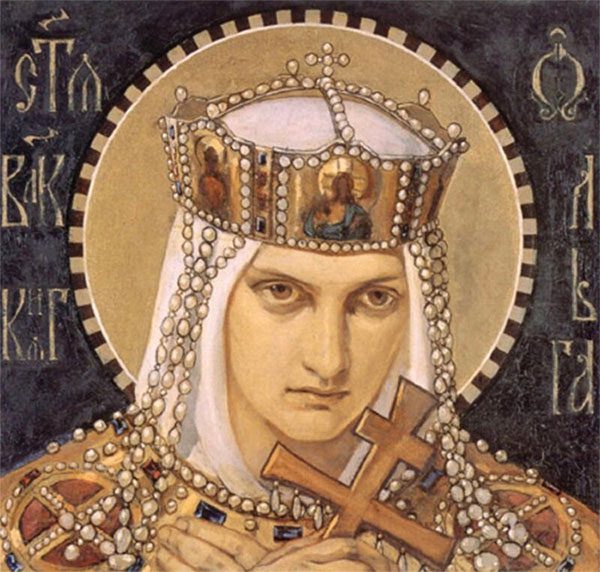
Saint “Olga of Kiev” was known for carrying out a brutal revenge. (Photo: Wikimedia Commons)
In 945, Prince Igor, who ruled Kievan Rus (a vast principality that includes present-day Ukraine, Belarus, and Russia, with its capital in Kiev), traveled to the fringes of his empire. A local tribe known as the Drevlian stopped paying tribute, captured Igor, and subjected him to a horrific form of torture and execution. However, shortly after, the Drevlian would pay dearly for the brutal revenge of Igor’s wife, Princess “Olga of Kiev.”
For 15 years following her husband’s death, Princess Olga dedicated almost all her time to finding ways to annihilate the Drevlian. In 1547, the Russian Orthodox Church canonized her, and today, “Olga of Kiev” remains the patron saint of widows and converts in Ukraine.
The Regent of Kievan Rus
Princess Olga was born around 900 in what is now Pskov, Russia, near the border with Estonia. At that time, the city was part of the vast Viking empire known as Kievan Rus.
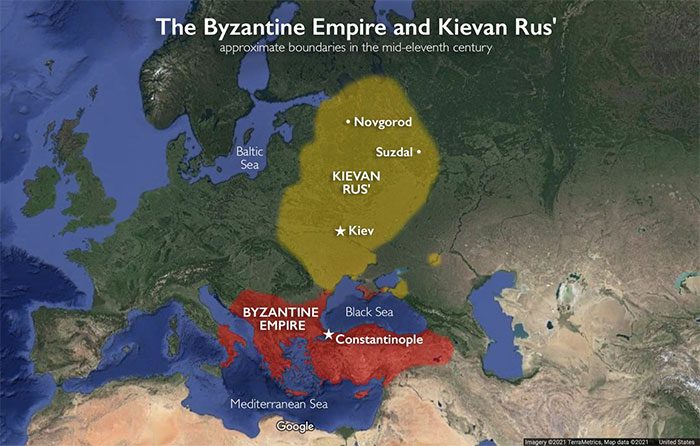
The Byzantine Empire (in red), with its capital in Constantinople, and the Kievan Rus Empire (in blue), with Kiev as its capital around the mid-11th century.
Olga herself was a Varangian, a descendant of the first Vikings who settled in the Kievan Rus empire. At under 15 years old, she married Grand Prince Igor I, who ruled Kievan Rus.
Just a generation earlier, Igor’s predecessor and guardian, Prince Oleg, had consolidated power in Kievan Rus and established the new capital in Kiev. However, there was one tribe he could not fully control: the Drevlian. With their own identity and goals, the Drevlian sided with Kievan Rus in conflicts with the Byzantine Empire and paid respect to Oleg. But when he died in 945, their attitude changed.
That year, when Prince Igor arrived at the capital of the Drevlian tribe (now the city of Korosten in northern Ukraine) to collect tribute, they brutally murdered him. According to Byzantine chronicles, “they bent two birch trees down, tied them to both legs of the prince. Then they let the trees go straight again, tearing the prince in two.”
However, the Drevlian underestimated his wife – Princess Olga. At that time, Olga was about 20 years old and had a three-year-old son named Sviatoslav. Because her son was too young to rule, Olga took on the regency of Kievan Rus.
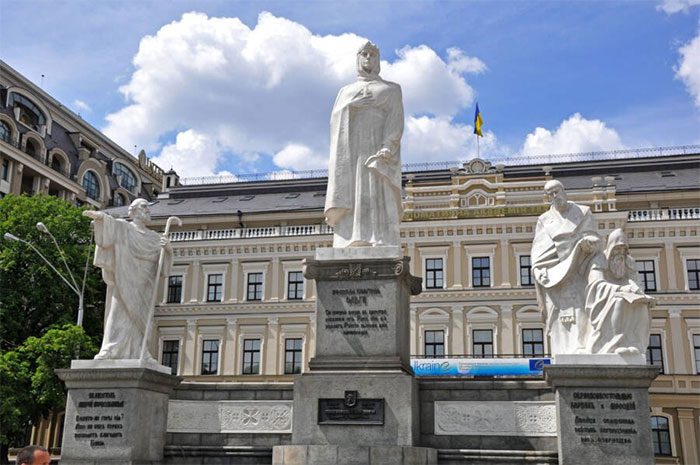
Monument to Princess Olga in Michael’s Square, Kiev. (Photo: Wikimedia Commons)
Immediately, Princess “Olga of Kiev” began her efforts to take revenge on the Drevlian. And it was her enemies who provided her with an opportunity.
After brutally killing Prince Igor, Prince Mal of the Drevlian shamelessly proposed to the regent of Kievan Rus. At that time, Olga was still single, and Mal thought he could bring Kievan Rus under Drevlian control through marriage.
Before Igor’s body even had time to cool, Mal sent twenty noblemen to Kiev to persuade Olga to marry him. Of course, Olga had no intention of marrying the man who had killed her husband. Nevertheless, the Drevlian’s proposal gave her an opportunity. Instead of refusing the offer, Olga welcomed the envoys to Kiev and promised to honor them. She then ordered her soldiers to dig a trench.
The next day, the envoys, dressed elegantly, arrived for the reception. Olga led them to the edge of the trench and signaled her soldiers to throw them all into the trench, burying them alive.
Princess Olga of Kiev was still not satisfied. After burying the Drevlian envoys alive, Olga immediately began to plan her next act of revenge.
Before news of Olga’s revenge reached the Drevlian, the princess wrote to Prince Mal. Olga requested Mal to send his best warriors to escort her back to Drevlian as his bride.
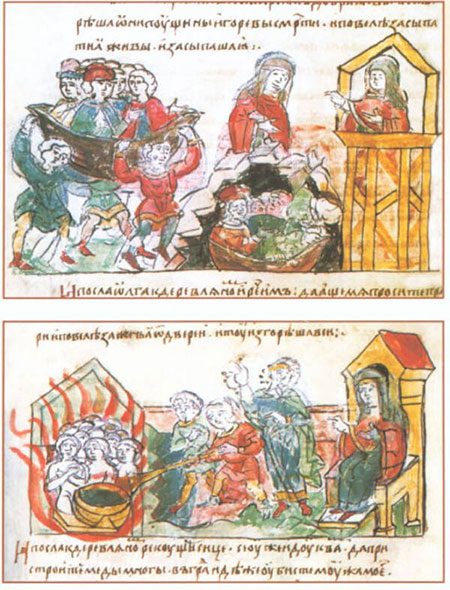
Olga took revenge by burying and burning the envoys of her enemies – an illustration from a 15th-century chronicle. (Source: Wikimedia Commons)
The Consecutive and Brutal Revenge
Unaware of Olga’s wrath and the fact that the twenty envoys had been killed, Mal continued to send a group of leaders to escort her.
When the Drevlian leaders arrived, Olga suggested they bathe after their journey. And when they entered the bathhouse, the regent locked the door and burned the entire building down. No one survived.
Olga was still not satisfied, but she knew she had to act quickly. Before Mal and the Drevlian realized the bloody fate of the envoys, Olga moved quickly with her army towards the north of the Drevlian capital.
Upon arrival, she held a funeral feast for her husband and invited the Drevlian warriors to attend as a gesture of goodwill. But when the Drevlian were drunk, Olga’s loyal warriors drew their swords and slaughtered 5,000 men.
At that point, the Drevlian feared Olga would not stop until she had completely annihilated their tribe. The survivors knelt and begged Olga to accept tribute and return to Kiev.
The princess of Kievan Rus refused the offer; instead, she besieged the Drevlian capital for over a year until they pleaded for mercy.
Olga made a peace proposal. “Give me three pigeons and three sparrows from each household,” the ancient Eastern Slavic chronicle of Kievan Rus records. “I do not wish to impose a heavy tribute like my husband; I only ask for this small gift from you,” Olga said.
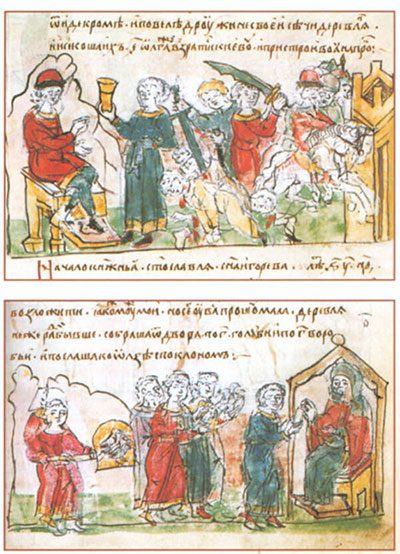
An illustration of Princess Olga’s next revenge. (Photo: Wikimedia Commons)
The Drevlian immediately agreed, surprised by the small price to pay for peace. But Olga had a different plan.
The Kievan Rus chronicle records: “At this point, Olga gave each soldier in her army a pigeon or a sparrow, ordering them to tie a piece of sulfur to each bird’s leg with small pieces of cloth.”
That night, Olga instructed her soldiers to light the cloth and release the birds. The flock of birds immediately flew back to their nests within the thatched houses of the Drevlian, simultaneously igniting terrible fires.
According to the Kievan Rus chronicle, “Not a single house was left unburned, and the fire could not be extinguished because all the houses caught fire at once.”
“The people tried to flee the town, and Olga ordered her soldiers to capture them. She took the city, set it ablaze, and captured the elders of the Drevlian,” the princess of Kiev slaughtered the captives, some were sold into slavery, and only a few were allowed to stay behind to rebuild the town.
The horrific revenge of the Kievan Rus regent was finally complete, leaving the Drevlian tribe shattered and destroyed.
Canonized by Catholicism and Orthodoxy
“Olga of Kiev” burned her enemies alive, buried the envoys, and destroyed an entire town. So how did she become a saint in the Roman Catholic and Eastern Orthodox churches?
In the 10th century, when Olga ruled the Kievan Rus, they were all pagans, descended from Vikings in Northern Europe. Meanwhile, the Byzantine Empire near Kiev was on a mission to convert their neighbors to Christianity.
After Olga completed her revenge against the Drevlian, Emperor Constantine VII invited her to visit Constantinople. On that journey, Olga converted to Christianity. And upon returning to Kiev, she also urged her subjects to convert.
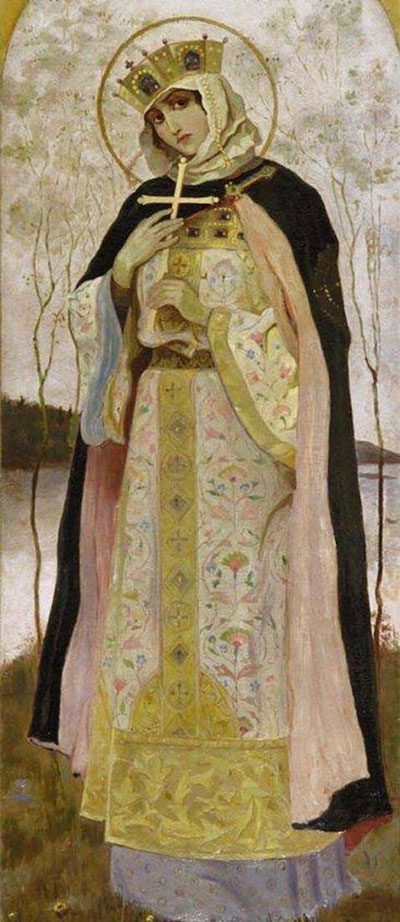
A 19th-century painting depicting Saint Olga of Kiev. (Photo: Wikimedia Commons)
The Byzantines declared Olga “equal to the Apostles” for her conversion. “She shone like the moon at night,” the Byzantine chronicles recorded, “and she radiated among the pagans like a gem in a mire, for the people were defiled and had not been cleansed of sin by baptism.”
The Byzantine emperor also agreed. When Emperor Constantine VII met Olga, he proposed marriage to her. The princess of Kiev declined, but this time, she did so without shedding blood.
Later, in 1547, the Russian Orthodox Church also officially canonized Princess Olga of Kievan Rus as “Saint Olga of Kiev,” the patron saint of widows and converts.





















































